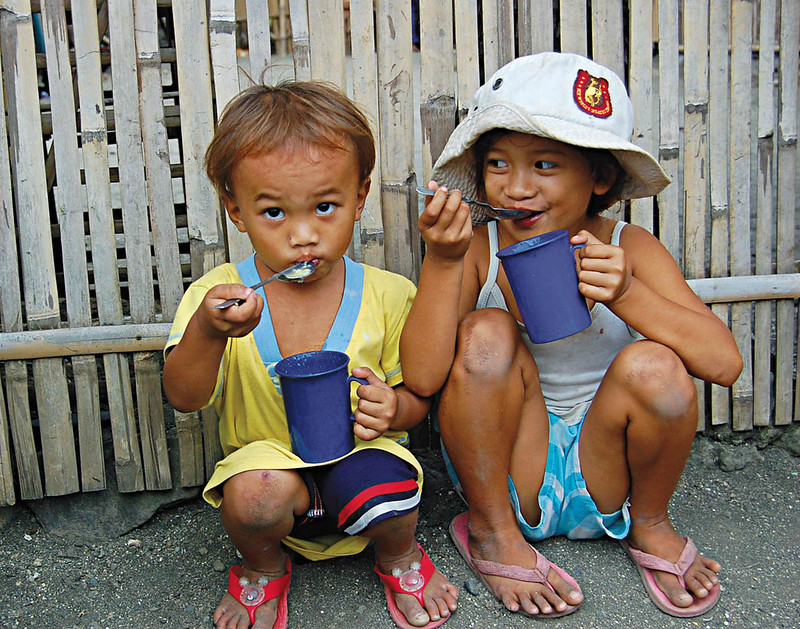Understanding Poverty Reduction in the Philippines
 In the Philippines, poverty has been prevalent in the lives of millions, with 22.4% of its population living below the national poverty line and 9.79 million Filipinos unable to meet their basic food needs. However, due to the efforts of poverty reduction in the Philippines, there has been a notable decrease from 2021, which saw a poverty rate of 23.7%.
In the Philippines, poverty has been prevalent in the lives of millions, with 22.4% of its population living below the national poverty line and 9.79 million Filipinos unable to meet their basic food needs. However, due to the efforts of poverty reduction in the Philippines, there has been a notable decrease from 2021, which saw a poverty rate of 23.7%.
With increasing urbanization and a growing middle class, poverty reduction in the Philippines is a crucial pathway toward understanding development goals and uncovering opportunities for advancement. This article will delve into the multifaceted approaches in the Philippines’ poverty reduction, analyze the strategies put in place so far and identify challenges to achieving President Ferdinand Marcos Jr’s plan to bring poverty in the Philippines down to 9% by 2028.
Current State
As evidenced by the Philippine Statistics Authority (PSA) and the Asian Development Bank (ADB), the current state of poverty in the Philippines is one of slow but resilient progress. According to the PSA, the Proportion of Poor among families has fallen from 18% to 16.4% between 2021 and 2023, highlighting some initial progress in poverty reduction efforts.
However, the PSA’s data also indicates that urban areas, such as Manila, which has a Poverty Incidence of 5.7%, have much lower levels of poverty than rural areas, such as Leyte, which has a Poverty Incidence of 31.3%, indicating a significant urban-rural gap. By addressing factors such as access to education, health care and employment opportunities and recognizing these disparities between urban and rural areas, we can implement effective policies to foster inclusive poverty reduction in the Philippines.
Government Initiatives
Regarding government initiatives, the Philippines’ Department of Social Welfare and Development (DSWD) has implemented a program known as the Pantawid Pamilyang Pilipino Program (4Ps). This program promises to provide conditional cash grants to poorer households to improve the health and education of children living below the national poverty line. As of August 2015, program recipients received P27.15 billion ($0.48 billion) in cash grants.
Meanwhile, another government initiative, the Sustainable Livelihood Program (SLP), started in 2011. This program generated employment among poor households and moved highly vulnerable households into more sustainable livelihoods, intending to expand poverty reduction in the Philippines. The program has grown from serving 46,000 families in 2011 to serving 166,000 families in 2017. Despite these efforts, challenges such as limited resources persist. However, sustainable poverty reduction is possible through monitoring and evaluating program performance and fostering transparency.
Nongovernmental Efforts
In addition to government initiatives, several nongovernmental organizations (NGOs) play a crucial role in poverty reduction in the Philippines. Organizations such as the Zero Extreme Poverty PH 2030 (ZEP) are actively involved in addressing the root causes of poverty, focusing on eight themes: Health, Education, Environment, Livelihood and Employment, Agriculture and Fisheries, Housing and Shelter, Peace and Human Security and Social Justice.
Zero Poverty PH has achieved many notable accomplishments in poverty reduction efforts. It installed a water system in Tayabasan, benefiting more than 215 families by giving them clean drinking water. Moreover, its goal to have two million Opportunity Youth in employment or self-employment by 2030 is already in progress. For example, Jonalyn, age 17, who had to drop out of school to support her family, is now receiving support from ZEP to continue her education at Hilamonan Elementary School, along with 300 other students. By working closely with communities, nongovernmental organizations can implement targeted goals that address specific needs and challenges.
Economic Challenges and Future Directions
However, alongside socioeconomic disparities, the Philippines also faces several environmental challenges from changing weather patterns, like typhoons and floods. These disasters have tragic consequences for people experiencing poverty, resulting in loss of livelihoods or homes and further deprivation. Furthermore, environmental factors such as pollution and deforestation threaten food security and create health risks.
As the lead plastic polluter in 2019, the Philippines is responsible for 36.38% of global oceanic plastic waste. Undoubtedly, this is having dire effects on those in poverty. Whether through water-transmitted illnesses or threats to livestock due to the endocrine-disrupting chemicals in the plastic, which are linked to several issues such as infertility, cancer, diabetes and increased risk of cardiovascular disease and strokes.
Moreover, government initiatives such as the Extended Producer Responsibility Act (EPRA), introduced in 2022, which requires companies to create EPR programs for plastic waste reduction, recovery and diversion, have set an expectation for an 80% decline in their plastic product footprint. Furthermore, the Philippine government has implemented a National Plan of Action for the Prevention, Reduction and Management of Marine Litter to achieve zero waste in Philippine waters by 2040. This plan will create a wide range of policies, such as improving public awareness about marine pollution and participating in international coastal clean-ups, highlighting a wide approach towards their goal.
This is important for poverty reduction as plastic pollution can affect health through cancer, cardiovascular disease and more. Furthermore, plastic pollution affects farm animals and fish through choking or entanglement, which affects not only the amount of food around but also causes a massive dip in income for those who rely on this livelihood and fishing for income.
Final Remark
Poverty reduction in the Philippines requires multifaceted approaches that cover social, economic and environmental angles. While progress is being made through government and NGO initiatives, challenges continue to persevere. By prioritizing inclusive and sustainable policies, there is a strong chance that the Philippines will continue striving toward a prosperous future.
– Emily Weir
Photo: Flickr
